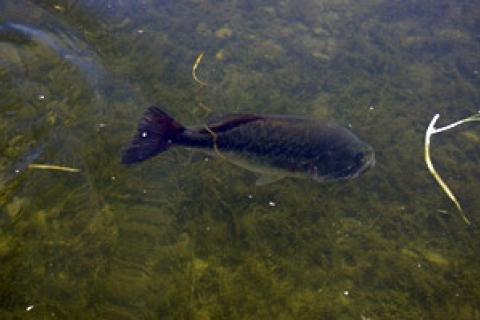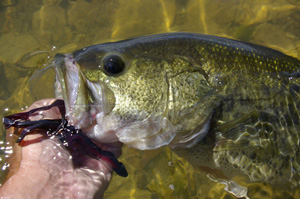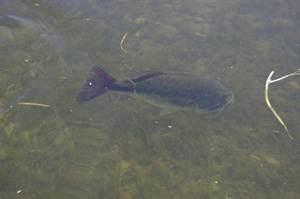
No other form of bass fishing conjures up as much excitement as the technique of sight fishing. I liken it to a strategic chess match played out on water — your "enemy" is visibly swimming before you, and those combatants that exhibit patience, skill and the utmost dexterity will ultimately become victor.
 |
| Lizards make an excellent choice in fishing baits when tossing to spotted fish. |
This game does come with its own set of rules, but for those that follow them, the rewards can be great.
A Year-Round Fishing Tactic
Although primarily thought of as a spring time tactic, sight fishing is a technique that can be utilized throughout the seasons. But in order for it to be a viable option, certain criteria must be met.
Water clarity is of extreme importance. Without being able to visibly spot fish, this tactic becomes a futile exercise. Clear water is mandatory for optimum vision, but let it be known that the clearer the water is, the greater chance the fish have of also spotting you. My preference is for clear, yet slightly stained water. This still allows you to see your targets, but lessens the chance of overly skittish or spooked bass.
A slight ripple on the water also puts the odds in your favor, as the surface refraction causes a decrease in the vision of bass, which aids in keeping them from seeing you. The greater the wind and wave action, the harder it becomes for an angler to spot anything below the surface.
Shallow water flats are best for locating fish, as the fairly uniform depth allows a larger area to cover, and visibility is best when fishing the skinny stuff. Over the years I've discovered that water that is between one and eight-feet deep will yield the greatest results. Keep this in mind for the season you fish, because if the bass go deep on your body of water in October or March, sight fishing is not in your best interest.
A variety of bottom structure is best to search out, and one of my best haunts for sight fishing is a back bay with sand, wood and sparse vegetation. If weeds are too thick, fish will become far too hard to spot, so concentrate on locations that have sporadic green stuff.
The springtime spawn is a popular time to seek out fish (check if it is legal in your area), as big females sit on nests protecting their young, and all bass of a breeding age flood the shallows to mate. Many times the small bucks will be the easy fish to catch, but persistence can pay off for those trophy girls. Bedding fish are generally not hungry, and will hit baits out of pure aggression, especially when defending their nests. Lizards and tubes are two excellent choices at this time, and working them repeatedly in the nest area is a proven method for getting these fish to bite.
Tools of the Trade
 |
| Always look well ahead of the boat when searching for fish. Any movement, whether on the surface or below, warrants a second look. |
Polarized sunglasses are the most important piece of equipment a sight-fishing angler can own. Without these "underwater eyes," the chances of spotting fish go way down. Choose a high-quality model, and experiment with different lens colors until you find one that works best for you. I've relied on a brown hue for many years now, and find that it is optimum for seeking out fish on the water I frequent.
Another handy addition to the glasses is a wide-brimmed hat or baseball cap. This will help cut down additional glare while also deflecting the sun's light rays.
Spinning gear will be your weapon of choice, as light fishing line and downsized baits come with the territory. A medium-action rod with a good backbone between 6 and 6 1/2 feet in length is standard, coupled with the smooth drag of a spinning reel. Keep line light to combat visibility below the surface, and if choosing monofilament line, 6- to 8-pound test works best. Fluorocarbon line is also an excellent choice for sight fishing, as it is more resistant to abrasion and has greater hiding qualities under water. Again, go with 6- to 8-pound test.
In terms of baits, soft plastics rule the roost. Lizards, tubes, craws and worms are all on my go-to list and work extremely well for this style of fishing. Three to 5-inch lures work best, as their size can still be spotted from a distance, but aren't too imposing to spook or scare fish away.
When rigging plastics, a 1/32- or 1/16-ounce screw-in worm weight is all you need, as this will present your bait in the most lifelike and tantalizing manner. If the fish are really in shallow, you may find that a weightless bait will bring the best results. Wacky worms work great for sight fishing, so keep that also in mind.
I prefer to keep the colors of my baits fairly neutral, as you will be dealing with clear water and fish that can take their time to decipher if something isn't right. Brown, black, white, junebug and watermelon have rewarded me well in the past. Whatever bait you choose, smothering it with a commercial fish scent can only up your odds for getting bit.
Strategies and Techniques for Sight Fishing
Quiet is key when searching out shallow water fish, so pay close attention to your boats trolling motor or any loud noises coming from the boat. Push poles can offer a discreet method of movement and are a great option for the sight fisherman.
 |
| The author shown working a productive area. Keep electric motors on low and boat noises to a minimum. |
Always look well ahead of the boat when searching for fish. Any movement, whether it is on the surface or below, calls for a second and more stringent look. The motions you make can also alert fish, so try to keep still and movement-free when working a productive area.
The color of your clothing can also play a role in the amount of fish you catch. Bright garments can be spotted by vision-savvy fish, so light and neutral-colored hues make the most sense. The game of sight fishing isn't much different than a deer or turkey hunter trying to blend in with their surroundings.
When a fish is spotted, make your first cast count. A side-arm casting approach is best, as this will alleviate heavy landings and splashes. You want your bait to glide into the water as naturally and spook-free as possible. Feathering your line with your fingertips just prior to entering the water can aid in a splashless entry.
Always cast 5 or 6 feet in front of the bass and never directly at it. Landing a bait on top of a fish is a sure way to scare it. Be prepared to make long casts. The farther away you can position yourself and your boat from the fish, the greater your chances for success.
You want your bait to fall naturally, and if the fish doesn't inhale it right off the bat, let it come in to investigate. At this point, a fun game of cat and mouse begins. Quiver your lure, pulsate it or slowly raise it off bottom. Anything to tempt that fish to strike. Over time, and fish, you will learn what tactics and motions you can give your bait for the best chance at sealing the deal.
Sight fishing for largemouth bass throws a whole new twist on the angling game. Targeting and actively searching for fish with the naked eye can lead to excitement-packed days, and when conditions are just right, a steady bend in the rod and a smile on the face. Happy spotting!
- 15797 views

